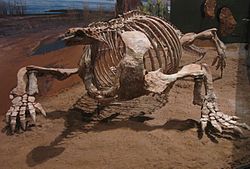
Back Cotylorhynchus Catalan Cotylorhynchus Czech Cotylorhynchus German Κοτυλόρυγχος Greek Cotylorhynchus Spanish Cotylorhynchus French קוטילורוניצוס HE Cotylorhynchus Hungarian Cotylorhynchus Italian コティロリンクス Japanese
| Cotylorhynchus | |
|---|---|

| |
| Skeleton of C. romeri on display at the Sam Noble Oklahoma Museum of Natural History. | |
| Scientific classification | |
| Domain: | Eukaryota |
| Kingdom: | Animalia |
| Phylum: | Chordata |
| Clade: | Synapsida |
| Clade: | †Caseasauria |
| Family: | †Caseidae |
| Genus: | †Cotylorhynchus Stovall, 1937 |
| Type species | |
| †Cotylorhynchus romeri Stovall, 1937
| |
| Species | |
| |
Cotylorhynchus is an extinct genus of herbivorous caseid synapsids that lived during the late Lower Permian (Kungurian) and possibly the early Middle Permian (Roadian) in what is now Texas and Oklahoma in the United States. The large number of specimens found make it the best-known caseid. Like all large herbivorous caseids, Cotylorhynchus had a short snout sloping forward and very large external nares. The head was very small compared to the size of the body. The latter was massive, barrel-shaped, and ended with a long tail. The limbs were short and robust. The hands and feet had short, broad fingers with powerful claws. The barrel-shaped body must have housed large intestines, suggesting that the animal had to feed on a large quantity of plants of low nutritional value. Caseids are generally considered to be terrestrial, though a semi-aquatic lifestyle has been proposed by some authors. The genus Cotylorhynchus is represented by three species, the largest of which could reach more than 6 m in length. However, a study published in 2022 suggests that the genus may be paraphyletic, with two of the three species possibly belonging to separate genera.
© MMXXIII Rich X Search. We shall prevail. All rights reserved. Rich X Search